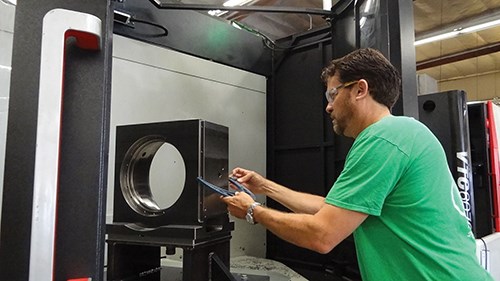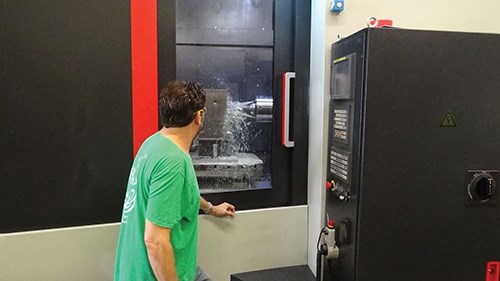HMC Saves Floor Space, Increases Production Capacity
When Calmotion LLC's production capacity fell behind demand for its rotary products, it added horizontal machining with the SMTCL HMC80 for reduced operations and setup times.
Manufacturing challenges don’t always end once a company successfully makes a product. In fact, success often leads to increased production, which, in turn, presents unexpected additional challenges. Calmotion LLC (Chatsworth, California) had to change its machining process when demand for its rotary products increased. By adding horizontal machining from SMTCL Americas (City of Industry, California), however, the company was able to avoid adding many more machines and additional floor space.
Calmotion specializes in manufacturing control and mechanical products for CNC applications. With more than 60 years in the machine tool industry, owner Larry de Caussin says that the machines cutting his products are the most important factor in producing quality parts.
Mr. de Caussin, who with his family introduced Fadal vertical machining centers, has developed a line of rotary products designed for cost-effective four- and five-axis machining. Machining of Calmotion’s rotary tables has to be extremely accurate, as any product deviation is magnified the farther a customer machines from the center of rotation. Also, the rigid, heavy castings require a powerful machine to remove chips.
To meet these requirements, Mr. de Caussin originally relied on the high-torque spindles and boxway construction of the Fadal vertical machining centers. However, high customer demand for the rotary product and the introduction of new product designs became a challenge for Calmotion. The only way to increase production without adding machines and floor space was to change the manufacturing process.
Rodney de Caussin, senior vice president, met with Jerry McCarty of SMTCL to discuss ways to increase production. The men agreed that horizontal machining was a natural step. By using a two-pallet machine, Calmotion could reduce the number of operations and setup time, Mr. de Caussin says. As an added benefit, he could see the horizontal running at SMTCL’s Southern California Technical Center before he purchased it.
Once Mr. de Caussin put the SMTCL HMC80 into production, he realized that it was doing the work of six VMCs in terms of efficiency. The HMC’s 653 foot-pounds of torque combined with 1,570-ipm rapids also reduced cycle times, and the 800-mm pallets provided a large work area for the company’s custom fixtures. Calmotion was able to increase speeds and feeds while realizing all the setup benefits of a horizontal. For instance, after the program finished on the VMC, the operator would blow off chips, unload the finished part, and set up a new part in the fixture. This process took about 5 min. while the machine sat idle. With the dual-pallet system on the HMC, the entire process takes place on the idle pallet while the spindle is machining a part on the active pallet, enabling the company to produce 20 percent more parts per shift than it could on the VMC.
And, although it removes metal much faster, the 70,000-pound machine remains extremely rigid.
“This shows up in the part finish, which is just beautiful,” Mr. de Caussin says.
The transition from vertical to horizontal machining meant that Calmotion had to reprogram the part. However, the ability to run the part in just one setup ended up saving time by combining what was previously four programs. Also, the SMTCL HMC80’s 50-taper spindle enables a heavier cut, and its faster rapids resulted in a time savings of 20 percent. One-step machining prevents work in progress, which helps with shop cleanliness and less scrap, the company says.
In addition, the high-pressure through-tool coolant is designed to move chips off the part more efficiently and keep it cleaner. Previously, the company redirected coolant by hand, but that is no longer the case. Without operator intervention, the shop is able to realize even more time savings, Mr. de Caussin says.
Another way the HMC helped ramp up production was through increased tool life. Although Calmotion uses the same size cutting tools as it previously did on the VMC, the 50-taper HMC’s rigidity and weight produces less vibration, which, in turn, increases tool life.
“There have been no complications or handicaps with the tooling, and it has been a smooth transition,” Mr. de Caussin says.
The SMTCL HMC80 is wired for a Renishaw NC4 laser tool-setting drill. The larger toolchanger enables duplicate tools, which enables Calmotion to immediately replace worn tools automatically, lowering setup and maintenance time.
When asked about the overall thoughts on their new HMC, Mr. de Caussin says, “It has all of the benefits we had hoped for. Although the chip management was not expected, it was a great plus. After 60 years of being in the machine tool industry, even I am impressed.”
Related Content
Buying a Lathe: The Basics
Lathes represent some of the oldest machining technology, but it’s still helpful to remember the basics when considering the purchase of a new turning machine.
Read MoreVolumetric Accuracy Is Key to Machining James Webb Telescope
To meet the extreme tolerance of the telescope’s beryllium mirrors, the manufacturer had to rely on stable horizontal machining centers with a high degree of consistency volumetric accuracy.
Read MoreHow to Start a Swiss Machining Department From Scratch
When Shamrock Precision needed to cut production time of its bread-and-butter parts in half, it turned to a new type of machine tool and a new CAM system. Here’s how the company succeeded, despite the newness of it all.
Read MoreA New Milling 101: Milling Forces and Formulas
The forces involved in the milling process can be quantified, thus allowing mathematical tools to predict and control these forces. Formulas for calculating these forces accurately make it possible to optimize the quality of milling operations.
Read MoreRead Next
The Cut Scene: The Finer Details of Large-Format Machining
Small details and features can have an outsized impact on large parts, such as Barbco’s collapsible utility drill head.
Read More3 Mistakes That Cause CNC Programs to Fail
Despite enhancements to manufacturing technology, there are still issues today that can cause programs to fail. These failures can cause lost time, scrapped parts, damaged machines and even injured operators.
Read More











.jpg;maxWidth=300;quality=90)







.png;maxWidth=300;quality=90)










